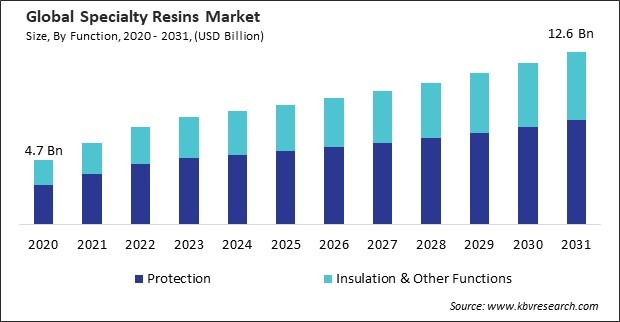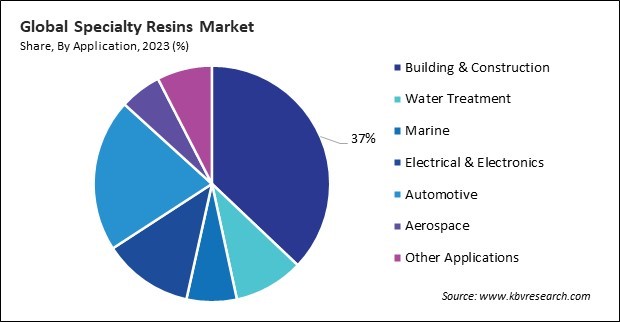“Global Specialty Resins Market to reach a market value of 12.6 Billion by 2031 growing at a CAGR of 6.2%”
The Global Specialty Resins Market size is expected to reach $12.6 billion by 2031, rising at a market growth of 6.2% CAGR during the forecast period. In the year 2023, the market attained a volume of 2,755.0 kilo tonnes, experiencing a growth of 26.5% (2020-2023).
In the production of components such as insulators, encapsulants, and printed circuit boards (PCBs), specialty polymers are essential. They offer exceptional moisture resistance, thermal stability, and electrical insulation. Thus, the electrical & electronics segment acquired 12% revenue share in the market in 2023. In terms of volume, 463.4 kilo tonnes of Specialty Resins expected to be utilized by the year 2031 in electrical & electronics. The segment's expansion is fueled by the growing demand for high-performance materials in a variety of electronic applications. Moreover, the rapid growth of sectors like telecommunications, consumer electronics, and automotive electronics has further fueled the demand for specialty resins. The trend towards more complex electronic systems and devices, such as smartphones, electric vehicles, and smart home technologies, requires materials that can withstand higher temperatures and provide reliable electrical insulation.

The construction industry is vital in driving the demand for specialty resins in Europe. Countries like Germany, France, and the UK are witnessing significant construction activities, particularly in residential and commercial sectors. Specialty resins are used in these projects for various purposes, including architectural coatings, adhesives for insulation materials, and high-performance sealants. Additionally, with the expansion of the automotive industry, the focus has shifted to fuel efficiency and emissions reduction. Therefore, manufacturers are turning to lightweight materials to improve vehicle performance. Automakers are able to meet stringent fuel efficiency standards with the assistance of specialty resins, such as carbon fiber-reinforced composites, which provide a lightweight alternative to conventional materials like steel and aluminum. On top of that, the demand for specialty resins in the automotive industry has been fueled by the expanding demand for electric vehicles (EVs). Due to their excellent insulating properties and thermal stability, specialty resins are used in EV batteries, charging systems, and electrical components. It is anticipated that the demand for specialty resins will significantly increase alongside the transition towards electrification in the automotive industry. The demand for specialty resins is expected to grow, driven by the need for high-performance and sustainable construction materials. and the expanding automotive industry is driving significant growth in the demand for specialty resins.
However, the high production costs of specialty resins can impact the overall competitiveness of industries that rely heavily on these materials. Manufacturers may face challenges in pricing their products competitively, especially when competing against products made with lower-cost materials. This can limit the growth potential of industries that could benefit from the unique properties of specialty resins but are constrained by cost considerations. Hence, the high costs associated with these materials may hamper the market's growth.
Based on type, the market is divided into epoxy, vinyl, polyamides, unsaturated polyester resins, and others. The epoxy segment garnered 35% revenue share in the market in 2023. In terms of volume, 1,167.8 kilo tonnes of Epoxy resins expected to be utilized by the year 2031. Epoxy resins are highly regarded for their exceptional mechanical properties, chemical resistance, and adhesion, which make them applicable in various cases, such as composite materials, adhesives, and coatings.
On the basis of application, the market is classified into building & construction, water treatment, marine, electrical & electronics, automotive, aerospace, and others. The automotive segment garnered 21% revenue share in the market in 2023. In terms of volume, 1,857.4 kilo tonnes of specialty resins expected to be utilized in automotive by the year 2031. The automotive industry's demand for lightweight as well as high-performance materials is the driving force behind the use of specialty resins. These resins are designed to improve the overall performance of vehicles, reduce emissions, and increase fuel efficiency.

By function, the market is segmented into protection, insulation and others. The protection segment recorded 62% revenue share in the market. In terms of volume, 2,257.7 kilo tonnes of specialty resins expected to be utilized in protection function by the year 2031. The applications of specialty resins in this segment are extensive, as they are employed to protect a variety of products and materials from environmental damage, corrosion, and erosion. Industries such as automotive, aerospace, and construction rely heavily on protective coatings and adhesives made from specialty resins to enhance the durability and longevity of their products.
Free Valuable Insights: Global Specialty Resins Market size to reach USD 12.6 Billion by 2031
Region-wise, the market is analyzed across North America, Europe, Asia Pacific, and LAMEA. The Asia Pacific segment garnered 54% revenue share in the market in 2023. In terms of volume, 2,443.9 kilo tonnes of specialty resins expected to be utilized in this region by the year 2031. China, India, and Japan are among the countries in Asia Pacific that are experiencing rapid industrialization and urbanization, which is driving the demand for specialty resins in the region. The region is experiencing a surge in the development of infrastructure, which is leading to an increase in the demand for specialty resins in construction materials such as coatings, adhesives, and composites.
| Report Attribute | Details |
|---|---|
| Market size value in 2023 | USD 7.9 Billion |
| Market size forecast in 2031 | USD 12.6 Billion |
| Base Year | 2023 |
| Historical Period | 2020 to 2022 |
| Forecast Period | 2024 to 2031 |
| Revenue Growth Rate | CAGR of 6.2% from 2024 to 2031 |
| Quantitative Data | Volume in Kilo Tonnes, Revenue in USD Billion, and CAGR from 2020 to 2031 |
| Number of Pages | 387 |
| Tables | 790 |
| Report coverage | Market Trends, Revenue Estimation and Forecast, Segmentation Analysis, Regional and Country Breakdown, Porter’s 5 Forces Analysis, Company Profiling, Companies Strategic Developments, SWOT Analysis, Winning Imperatives |
| Segments covered | Function, Type, Application, Region |
| Country scope |
|
| Companies Included | BASF SE, Hexion Inc. (Hexion Intermediate Holding 2, Inc.), Saudi Basic Industries Corporation (SABIC), Koninklijke DSM N.V., Arkema S.A., Mitsubishi Chemical Holdings Corporation, The Dow Chemical Company, Huntsman Corporation, LyondellBasell Industries Holdings B.V., Lanxess AG |
By Function (Volume, Kilo Tonnes, USD Billion, 2020-2031)
By Application (Volume, Kilo Tonnes, USD Billion, 2020-2031)
By Type (Volume, Kilo Tonnes, USD Billion, 2020-2031)
By Geography (Volume, Kilo Tonnes, USD Billion, 2020-2031)
This Market size is expected to reach $12.6 billion by 2031.
Rapidly Expanding Construction Industry are driving the Market in coming years, however, High Production Costs of Specialty Resins restraints the growth of the Market.
BASF SE, Hexion Inc. (Hexion Intermediate Holding 2, Inc.), Saudi Basic Industries Corporation (SABIC), Koninklijke DSM N.V., Arkema S.A., Mitsubishi Chemical Holdings Corporation, The Dow Chemical Company, Huntsman Corporation, LyondellBasell Industries Holdings B.V., Lanxess AG
In the year 2023, the market attained a volume of 2,755.0 kilo tonnes, experiencing a growth of 26.5% (2020-2023).
The Building & Construction segment is leading the Market by Application in 2023; thereby, achieving a market value of $4.2 billion by 2031.
The Asia Pacific region dominated the Market by Region in 2023; thereby, achieving a market value of $6.7 billion by 2031.
Our team of dedicated experts can provide you with attractive expansion opportunities for your business.

 Drivers
Drivers
 Restraints
Restraints
 Opportunities
Opportunities
 Challenges
Challenges
